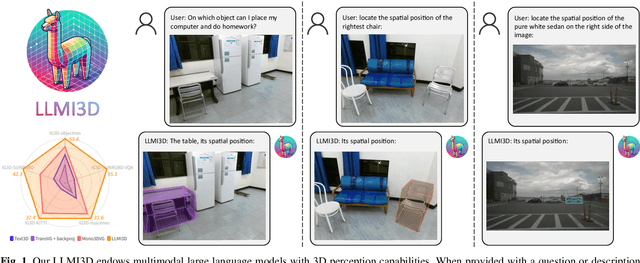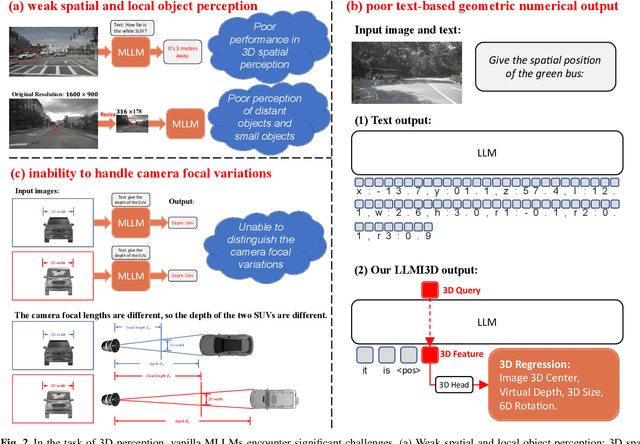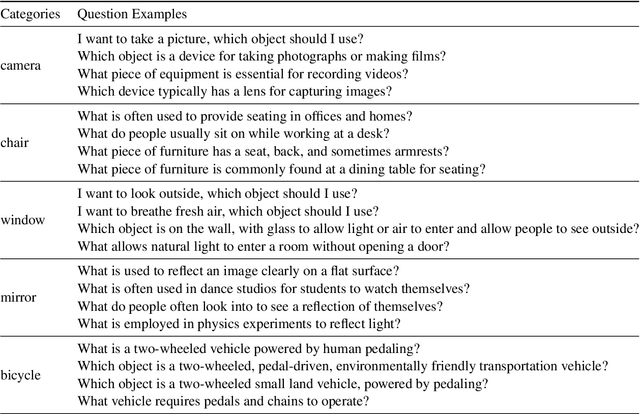Yanhao Zhang
Improved Visual-Spatial Reasoning via R1-Zero-Like Training
Apr 01, 2025Abstract:Increasing attention has been placed on improving the reasoning capacities of multi-modal large language models (MLLMs). As the cornerstone for AI agents that function in the physical realm, video-based visual-spatial intelligence (VSI) emerges as one of the most pivotal reasoning capabilities of MLLMs. This work conducts a first, in-depth study on improving the visual-spatial reasoning of MLLMs via R1-Zero-like training. Technically, we first identify that the visual-spatial reasoning capacities of small- to medium-sized Qwen2-VL models cannot be activated via Chain of Thought (CoT) prompts. We then incorporate GRPO training for improved visual-spatial reasoning, using the carefully curated VSI-100k dataset, following DeepSeek-R1-Zero. During the investigation, we identify the necessity to keep the KL penalty (even with a small value) in GRPO. With just 120 GPU hours, our vsGRPO-2B model, fine-tuned from Qwen2-VL-2B, can outperform the base model by 12.1% and surpass GPT-4o. Moreover, our vsGRPO-7B model, fine-tuned from Qwen2-VL-7B, achieves performance comparable to that of the best open-source model LLaVA-NeXT-Video-72B. Additionally, we compare vsGRPO to supervised fine-tuning and direct preference optimization baselines and observe strong performance superiority. The code and dataset will be available soon.
H2VU-Benchmark: A Comprehensive Benchmark for Hierarchical Holistic Video Understanding
Mar 31, 2025Abstract:With the rapid development of multimodal models, the demand for assessing video understanding capabilities has been steadily increasing. However, existing benchmarks for evaluating video understanding exhibit significant limitations in coverage, task diversity, and scene adaptability. These shortcomings hinder the accurate assessment of models' comprehensive video understanding capabilities. To tackle this challenge, we propose a hierarchical and holistic video understanding (H2VU) benchmark designed to evaluate both general video and online streaming video comprehension. This benchmark contributes three key features: Extended video duration: Spanning videos from brief 3-second clips to comprehensive 1.5-hour recordings, thereby bridging the temporal gaps found in current benchmarks. Comprehensive assessment tasks: Beyond traditional perceptual and reasoning tasks, we have introduced modules for countercommonsense comprehension and trajectory state tracking. These additions test the models' deep understanding capabilities beyond mere prior knowledge. Enriched video data: To keep pace with the rapid evolution of current AI agents, we have expanded first-person streaming video datasets. This expansion allows for the exploration of multimodal models' performance in understanding streaming videos from a first-person perspective. Extensive results from H2VU reveal that existing multimodal large language models (MLLMs) possess substantial potential for improvement in our newly proposed evaluation tasks. We expect that H2VU will facilitate advancements in video understanding research by offering a comprehensive and in-depth analysis of MLLMs.
Layton: Latent Consistency Tokenizer for 1024-pixel Image Reconstruction and Generation by 256 Tokens
Mar 12, 2025Abstract:Image tokenization has significantly advanced visual generation and multimodal modeling, particularly when paired with autoregressive models. However, current methods face challenges in balancing efficiency and fidelity: high-resolution image reconstruction either requires an excessive number of tokens or compromises critical details through token reduction. To resolve this, we propose Latent Consistency Tokenizer (Layton) that bridges discrete visual tokens with the compact latent space of pre-trained Latent Diffusion Models (LDMs), enabling efficient representation of 1024x1024 images using only 256 tokens-a 16 times compression over VQGAN. Layton integrates a transformer encoder, a quantized codebook, and a latent consistency decoder. Direct application of LDM as the decoder results in color and brightness discrepancies. Thus, we convert it to latent consistency decoder, reducing multi-step sampling to 1-2 steps for direct pixel-level supervision. Experiments demonstrate Layton's superiority in high-fidelity reconstruction, with 10.8 reconstruction Frechet Inception Distance on MSCOCO-2017 5K benchmark for 1024x1024 image reconstruction. We also extend Layton to a text-to-image generation model, LaytonGen, working in autoregression. It achieves 0.73 score on GenEval benchmark, surpassing current state-of-the-art methods. Project homepage: https://github.com/OPPO-Mente-Lab/Layton
HEIE: MLLM-Based Hierarchical Explainable AIGC Image Implausibility Evaluator
Nov 26, 2024



Abstract:AIGC images are prevalent across various fields, yet they frequently suffer from quality issues like artifacts and unnatural textures. Specialized models aim to predict defect region heatmaps but face two primary challenges: (1) lack of explainability, failing to provide reasons and analyses for subtle defects, and (2) inability to leverage common sense and logical reasoning, leading to poor generalization. Multimodal large language models (MLLMs) promise better comprehension and reasoning but face their own challenges: (1) difficulty in fine-grained defect localization due to the limitations in capturing tiny details; and (2) constraints in providing pixel-wise outputs necessary for precise heatmap generation. To address these challenges, we propose HEIE: a novel MLLM-Based Hierarchical Explainable image Implausibility Evaluator. We introduce the CoT-Driven Explainable Trinity Evaluator, which integrates heatmaps, scores, and explanation outputs, using CoT to decompose complex tasks into subtasks of increasing difficulty and enhance interpretability. Our Adaptive Hierarchical Implausibility Mapper synergizes low-level image features with high-level mapper tokens from LLMs, enabling precise local-to-global hierarchical heatmap predictions through an uncertainty-based adaptive token approach. Moreover, we propose a new dataset: Expl-AIGI-Eval, designed to facilitate interpretable implausibility evaluation of AIGC images. Our method demonstrates state-of-the-art performance through extensive experiments.
LLMI3D: Empowering LLM with 3D Perception from a Single 2D Image
Aug 14, 2024



Abstract:Recent advancements in autonomous driving, augmented reality, robotics, and embodied intelligence have necessitated 3D perception algorithms. However, current 3D perception methods, particularly small models, struggle with processing logical reasoning, question-answering, and handling open scenario categories. On the other hand, generative multimodal large language models (MLLMs) excel in general capacity but underperform in 3D tasks, due to weak spatial and local object perception, poor text-based geometric numerical output, and inability to handle camera focal variations. To address these challenges, we propose the following solutions: Spatial-Enhanced Local Feature Mining for better spatial feature extraction, 3D Query Token-Derived Info Decoding for precise geometric regression, and Geometry Projection-Based 3D Reasoning for handling camera focal length variations. We employ parameter-efficient fine-tuning for a pre-trained MLLM and develop LLMI3D, a powerful 3D perception MLLM. Additionally, we have constructed the IG3D dataset, which provides fine-grained descriptions and question-answer annotations. Extensive experiments demonstrate that our LLMI3D achieves state-of-the-art performance, significantly outperforming existing methods.
R$^2$-Gaussian: Rectifying Radiative Gaussian Splatting for Tomographic Reconstruction
May 31, 2024Abstract:3D Gaussian splatting (3DGS) has shown promising results in image rendering and surface reconstruction. However, its potential in volumetric reconstruction tasks, such as X-ray computed tomography, remains under-explored. This paper introduces R2-Gaussian, the first 3DGS-based framework for sparse-view tomographic reconstruction. By carefully deriving X-ray rasterization functions, we discover a previously unknown integration bias in the standard 3DGS formulation, which hampers accurate volume retrieval. To address this issue, we propose a novel rectification technique via refactoring the projection from 3D to 2D Gaussians. Our new method presents three key innovations: (1) introducing tailored Gaussian kernels, (2) extending rasterization to X-ray imaging, and (3) developing a CUDA-based differentiable voxelizer. Extensive experiments demonstrate that our method outperforms state-of-the-art approaches by 0.93 dB in PSNR and 0.014 in SSIM. Crucially, it delivers high-quality results in 3 minutes, which is 12x faster than NeRF-based methods and on par with traditional algorithms. The superior performance and rapid convergence of our method highlight its practical value.
PoseAnimate: Zero-shot high fidelity pose controllable character animation
Apr 30, 2024Abstract:Image-to-video(I2V) generation aims to create a video sequence from a single image, which requires high temporal coherence and visual fidelity with the source image.However, existing approaches suffer from character appearance inconsistency and poor preservation of fine details. Moreover, they require a large amount of video data for training, which can be computationally demanding.To address these limitations,we propose PoseAnimate, a novel zero-shot I2V framework for character animation.PoseAnimate contains three key components: 1) Pose-Aware Control Module (PACM) incorporates diverse pose signals into conditional embeddings, to preserve character-independent content and maintain precise alignment of actions.2) Dual Consistency Attention Module (DCAM) enhances temporal consistency, and retains character identity and intricate background details.3) Mask-Guided Decoupling Module (MGDM) refines distinct feature perception, improving animation fidelity by decoupling the character and background.We also propose a Pose Alignment Transition Algorithm (PATA) to ensure smooth action transition.Extensive experiment results demonstrate that our approach outperforms the state-of-the-art training-based methods in terms of character consistency and detail fidelity. Moreover, it maintains a high level of temporal coherence throughout the generated animations.
LoopAnimate: Loopable Salient Object Animation
Apr 14, 2024Abstract:Research on diffusion model-based video generation has advanced rapidly. However, limitations in object fidelity and generation length hinder its practical applications. Additionally, specific domains like animated wallpapers require seamless looping, where the first and last frames of the video match seamlessly. To address these challenges, this paper proposes LoopAnimate, a novel method for generating videos with consistent start and end frames. To enhance object fidelity, we introduce a framework that decouples multi-level image appearance and textual semantic information. Building upon an image-to-image diffusion model, our approach incorporates both pixel-level and feature-level information from the input image, injecting image appearance and textual semantic embeddings at different positions of the diffusion model. Existing UNet-based video generation models require to input the entire videos during training to encode temporal and positional information at once. However, due to limitations in GPU memory, the number of frames is typically restricted to 16. To address this, this paper proposes a three-stage training strategy with progressively increasing frame numbers and reducing fine-tuning modules. Additionally, we introduce the Temporal E nhanced Motion Module(TEMM) to extend the capacity for encoding temporal and positional information up to 36 frames. The proposed LoopAnimate, which for the first time extends the single-pass generation length of UNet-based video generation models to 35 frames while maintaining high-quality video generation. Experiments demonstrate that LoopAnimate achieves state-of-the-art performance in both objective metrics, such as fidelity and temporal consistency, and subjective evaluation results.
Increasing SLAM Pose Accuracy by Ground-to-Satellite Image Registration
Apr 14, 2024Abstract:Vision-based localization for autonomous driving has been of great interest among researchers. When a pre-built 3D map is not available, the techniques of visual simultaneous localization and mapping (SLAM) are typically adopted. Due to error accumulation, visual SLAM (vSLAM) usually suffers from long-term drift. This paper proposes a framework to increase the localization accuracy by fusing the vSLAM with a deep-learning-based ground-to-satellite (G2S) image registration method. In this framework, a coarse (spatial correlation bound check) to fine (visual odometry consistency check) method is designed to select the valid G2S prediction. The selected prediction is then fused with the SLAM measurement by solving a scaled pose graph problem. To further increase the localization accuracy, we provide an iterative trajectory fusion pipeline. The proposed framework is evaluated on two well-known autonomous driving datasets, and the results demonstrate the accuracy and robustness in terms of vehicle localization.
Homography Guided Temporal Fusion for Road Line and Marking Segmentation
Apr 11, 2024Abstract:Reliable segmentation of road lines and markings is critical to autonomous driving. Our work is motivated by the observations that road lines and markings are (1) frequently occluded in the presence of moving vehicles, shadow, and glare and (2) highly structured with low intra-class shape variance and overall high appearance consistency. To solve these issues, we propose a Homography Guided Fusion (HomoFusion) module to exploit temporally-adjacent video frames for complementary cues facilitating the correct classification of the partially occluded road lines or markings. To reduce computational complexity, a novel surface normal estimator is proposed to establish spatial correspondences between the sampled frames, allowing the HomoFusion module to perform a pixel-to-pixel attention mechanism in updating the representation of the occluded road lines or markings. Experiments on ApolloScape, a large-scale lane mark segmentation dataset, and ApolloScape Night with artificial simulated night-time road conditions, demonstrate that our method outperforms other existing SOTA lane mark segmentation models with less than 9\% of their parameters and computational complexity. We show that exploiting available camera intrinsic data and ground plane assumption for cross-frame correspondence can lead to a light-weight network with significantly improved performances in speed and accuracy. We also prove the versatility of our HomoFusion approach by applying it to the problem of water puddle segmentation and achieving SOTA performance.
 Add to Chrome
Add to Chrome Add to Firefox
Add to Firefox Add to Edge
Add to Edge